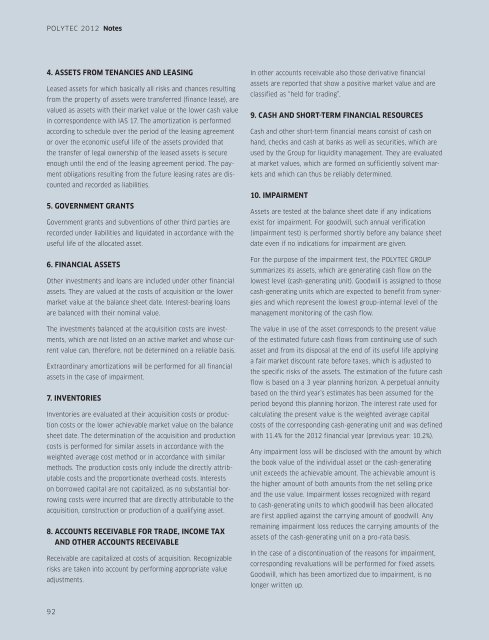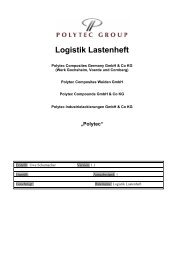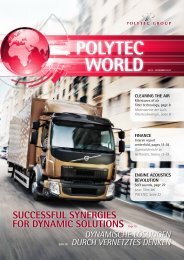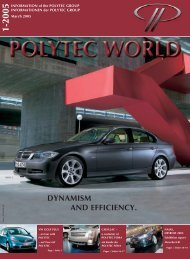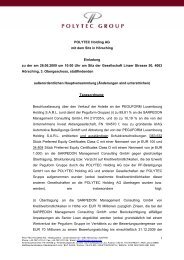Download - polytec
Download - polytec
Download - polytec
You also want an ePaper? Increase the reach of your titles
YUMPU automatically turns print PDFs into web optimized ePapers that Google loves.
POLYTEC 2012 Notes<br />
4. ASSets from tenancies and leASIng<br />
Leased assets for which basically all risks and chances resulting<br />
from the property of assets were transferred (finance lease), are<br />
valued as assets with their market value or the lower cash value<br />
in correspondence with IAS 17. The amortization is performed<br />
according to schedule over the period of the leasing agreement<br />
or over the economic useful life of the assets provided that<br />
the transfer of legal ownership of the leased assets is secure<br />
enough until the end of the leasing agreement period. The payment<br />
obligations resulting from the future leasing rates are discounted<br />
and recorded as liabilities.<br />
5. Government grants<br />
Government grants and subventions of other third parties are<br />
recorded under liabilities and liquidated in accordance with the<br />
useful life of the allocated asset.<br />
6. FinancIAl assets<br />
Other investments and loans are included under other financial<br />
assets. They are valued at the costs of acquisition or the lower<br />
market value at the balance sheet date. Interest-bearing loans<br />
are balanced with their nominal value.<br />
The investments balanced at the acquisition costs are investments,<br />
which are not listed on an active market and whose current<br />
value can, therefore, not be determined on a reliable basis.<br />
Extraordinary amortizations will be performed for all financial<br />
assets in the case of impairment.<br />
7. Inventories<br />
Inventories are evaluated at their acquisition costs or production<br />
costs or the lower achievable market value on the balance<br />
sheet date. The determination of the acquisition and production<br />
costs is performed for similar assets in accordance with the<br />
weighted average cost method or in accordance with similar<br />
methods. The production costs only include the directly attributable<br />
costs and the proportionate overhead costs. Interests<br />
on borrowed capital are not capitalized, as no substantial borrowing<br />
costs were incurred that are directly attributable to the<br />
acquisition, construction or production of a qualifying asset.<br />
8. Accounts receivABle for trADe, income tax<br />
and other accounts receivABle<br />
Receivable are capitalized at costs of acquisition. Recognizable<br />
risks are taken into account by performing appropriate value<br />
adjustments.<br />
In other accounts receivable also those derivative financial<br />
assets are reported that show a positive market value and are<br />
classified as “held for trading”.<br />
9. Cash and short-term financIAl resources<br />
Cash and other short-term financial means consist of cash on<br />
hand, checks and cash at banks as well as securities, which are<br />
used by the Group for liquidity management. They are evaluated<br />
at market values, which are formed on sufficiently solvent markets<br />
and which can thus be reliably determined.<br />
10. ImpAIrment<br />
Assets are tested at the balance sheet date if any indications<br />
exist for impairment. For goodwill, such annual verification<br />
(impairment test) is performed shortly before any balance sheet<br />
date even if no indications for impairment are given.<br />
For the purpose of the impairment test, the POLYTEC GROUP<br />
summarizes its assets, which are generating cash flow on the<br />
lowest level (cash-generating unit). Goodwill is assigned to those<br />
cash-generating units which are expected to benefit from synergies<br />
and which represent the lowest group-internal level of the<br />
management monitoring of the cash flow.<br />
The value in use of the asset corresponds to the present value<br />
of the estimated future cash flows from continuing use of such<br />
asset and from its disposal at the end of its useful life applying<br />
a fair market discount rate before taxes, which is adjusted to<br />
the specific risks of the assets. The estimation of the future cash<br />
flow is based on a 3 year planning horizon. A perpetual annuity<br />
based on the third year’s estimates has been assumed for the<br />
period beyond this planning horizon. The interest rate used for<br />
calculating the present value is the weighted average capital<br />
costs of the corresponding cash-generating unit and was defined<br />
with 11.4% for the 2012 financial year (previous year: 10.2%).<br />
Any impairment loss will be disclosed with the amount by which<br />
the book value of the individual asset or the cash-generating<br />
unit exceeds the achievable amount. The achievable amount is<br />
the higher amount of both amounts from the net selling price<br />
and the use value. Impairment losses recognized with regard<br />
to cash-generating units to which goodwill has been allocated<br />
are first applied against the carrying amount of goodwill. Any<br />
remaining impairment loss reduces the carrying amounts of the<br />
assets of the cash-generating unit on a pro-rata basis.<br />
In the case of a discontinuation of the reasons for impairment,<br />
corresponding revaluations will be performed for fixed assets.<br />
Goodwill, which has been amortized due to impairment, is no<br />
longer written up.<br />
92


